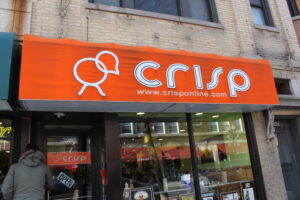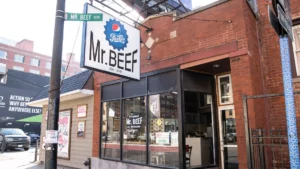By Oliver Styles (originally published on Wine Searcher on April 1, 2022)
The secret of terroir appears to have been unlocked this very day, in a groundbreaking paleontological study.

The secret of terroir – the concept that individual plots of land produce signature wines, some regularly better than wines from neighboring areas – appears to have been unlocked today, and the answer comes from an unexpected source: paleontology.
Dinosaur researchers working in the Cognac region began to piece together the answer when a satellite dig near the well-known Angeac-Charente dinosaur site got under way in the summer of 2021.
“We began excavating an area on a small slope that was known, many years ago, to produce some of the best wines in the commune,” Finnish paleontologist Lirpa Sloof, who heads-up the dig told news agency AFP yesterday. “For decades, though, the property has been in disrepair. The vines were pulled nearly 20 years ago but we still knew the area had significance.”
After digging trenches down to the Jurassic bedrock, Sloof and her team made something of a discovery.
“We found no [dinosaur] bones – which is always a bit sad,” said Sloof. “But we saw a very, very thin and unusual layer on the top of the rock – almost like the rock had been stained from the soil above. I could not explain but it was puzzling me. It’s not a thing I am used to seeing in digs around Jurassic rock.”
According to the scientist, she thought no more of it until Christmas time when, visiting family her husband’s family in the UK, she saw her sister-in-law’s youngest child soil itself on the carpet.
“That was the eureka moment,” she told Wine-Searcher.com last night. “When I got back to Cognac, I called up a New Zealand specialist in dinosaur coprolites [fossilised dung] and he came to visit in the new year.”
Dinosaur coprolite expert Jimmy Tutaengarara confirmed Sloof’s theory.
“Basically, the layer she had seen in the Cognac dig was a thin layer of homogeneous herbivore excrement,” he said. “We got pretty excited. I’ve been into wines since my time up the Mangahouanga [Stream] in Hawke’s Bay and, although Lirpa’s more of spirits drinker, she knows her wines, and we knew this had the potential to be significant.”
Sloof, Tutaengarara and the team then decamped to Burgundy’s Côte d’Or to test their theory. The resulting paper – Reptilian Coprolite Beds of the Côte d’Or, Cognac and the Central Loire – is due for publication in the Paleontological Journal this week.
“It’s hard to talk in certanties,” Sloof told Wine-Searcher.com. “Especially as, in the late Jurassic period, the Côte d’Or is thought to be something of a lagoon. But we think herbivore excrement was likely funnelled or collected in pools and then, in periods of heavy rain, washed into larger, basin-like areas but clung, or stayed near, the water’s edge – this gives us the famous mid-slope zone of the Côte d’Or.”
The team drilled down for rock samples, mainly at night. “We had to be pretty quick, especially around Vosne and in the Meursault area,” said Tutaengarara. “It got pretty gnarly trying to drill down at the top end of Romanée-Conti – we had to abandon that after an old guy in a flat cap came out shouting at us. But we got a great sample from La Tâche a couple of days later. It was much easier in Corton, the Combe de Lavaux [near Gevrey-Chambertin] and around Sancerre.”
However, the La Tâche sample led to another break-through.
“The excrement beds that make up – basically without exception – the premier and grand cru sites are interesting in that dinosaur excretement doesn’t usually show buoyancy – in other words it shouldn’t form along a shoreline,” said Tutaengarara. “So there are two possibilities. The main one is that the nutrition around this area in the late Jurassic was poor and led to flatulence in the sauropods and air being trapped in the faeces, making it float.
“That’s the basic premise we lay down. The La Tâche sample is interesting, however, in that I’m almost certain it is from a carnivore. I won’t go into the details but lining up grand cru sites with carnivore coprolites means we have to account for buoyancy in carnivore feces. Either we’re dealing with omnivorous behaviour on the part of the dinosaur – I guess you’d say it was a lagoon-straded, obligate herbivore – or the stools are particularly oily.”
Sloof sides with the latter theory but will not make a concrete statement either way. “You can’t really account for the positioning of the best sites in the middle of the rest of the good sites,” she says. “It is possible that, as a different species, the faeces will just float differently, but that’s a stretch if you’re saying it’s all through eating plant matter. I think the carnivores are producing oily stools and these are, basically, your Grand Cru sites.”
The team found this pattern throughout the Côte de Beaune and Côte de Nuits: premier and grand cru sites were based on a thin strata of late Jurassic dinosaur excrement. Furthermore, the numerous side valleys, or “combes” such as the Combe de Lavaux, west of Gevrey-Chambertin and the Saint-Aubin valley were basically sluices for the pools of faeces that had built up.
“Saint-Romain is the perfect example of what we think was a sort of cistern or bowl that then flooded out into the Meursault-Volnay–Pommard area,” added Tutaengarara. “It leaves residue across where it spilled out and then washes back against the slope, concentrating there before the water level recedes again.”
A long lunch
The team found the same in all the sites they examined, including Sancerre and Pouilly-Fumé.
“Looking into the slopes around Chavignol, it’s the same. We also suspect – but can’t prove – that, when you look at Saint-Andelain and, more particularly the Corton hill – or possibly even the Montrachet hill [above Puligny and Saint-Aubin] – it’s possible that a carnivore got stranded on the mound by the rising waters, likely with a rich food source – a large herbivore. The result of that extended meal is Le Montrachet or Corton-Charlemagne,” said Sloof.
Sloof and Tutaengarara have moved on to Jura region although, in recent weeks they have been in Bordeaux.
“I wanted to test some theories I developed moving on from this really fertile ground,” said Tutaengarara. “We’re relatively sure the likes of Tuscany will reinforce our findings in terms of best sites and dinosaur excretions. But, having always loved my big, structured reds, I wanted to look into the wines of of South West France.”
“Bordeaux in the Jurassic is more-or-less under water,” he continued. “The Médoc is pretty straightforward, we just can’t explain why large numbers of Mosasaurs are choosing to defacate in that particular area. Our best theory is that the region is something of an abundant feeding lane for the larger, sea-going dinosaurs.”
One possibility, advanced by retired French paleontologist Bernard Chiemou, with whom the team stayed, is that the layer of dinosaur excretions that forms the great terroir of the Médoc is the result of a mass herding of smaller marine reptiles by larger ones, such as Mosasaurs.
“So they are herded to together in big groups,” Chiemou told regional newspaper Sud-Ouest at the weekend, “and in their fear, the herded animals evacuate their bowels. I believe this will have happened with a certain level of regularity – maybe to do with the particular underwater dynamics in that area.”
The feeding zones appear to correspond to positions around the likes of Margaux, Saint-Julien, Pauillac and Saint-Estèphe. Given the large areas of vineyard, Sloof says sampling was easiest here.
“We got a fantastic drilled soil sample from [Château] Margaux although Lafite was tricky,” said Sloof. “We had to jump over the wall and be quick. The positive here is that we are about 98 percent sure that if Domaines des Barons de Lafite decide to drain the lake at the front of the property, this will be the greatest terroir in all of the region.”
Haut-Brion was difficult to sample due to its urban nature and the team have vowed to return. Sauternes, however, was a breeze apart from one notable encounter.
“We’re as close to certain as we can be that Sauternes, and in particular the Yquem slope, was a Mosasaur or Plesiosaur nursery zone,” said Sloof. “Jimmy wears the scars he received when he was discovered soil sampling just outside the château. The bruises are gone but it’s like a badge of honor for him.”
According to Tutaengarara, Pierre Lurton had discovered him making a soil drill while Lurton was barrel sampling.
“All he had was a barrel thief,” said Tutaengarara. “I went to give him a hug – Yquem is like hallowed ground, you know – but he wasn’t very happy. Those things can hurt.”
Lurton could not be reached for comment and, according to the team, they also steered clear of Cheval-Blanc when they came to Saint-Emilion and Pomerol.
“Some of the Right Bank is easy – you look at the slopes below Saint-Emilion town and it’s a bit like Burgundy, although its underwater, of course. We think we have these pockets of heavier-than-water excretions that are holding up against the slopes before breaking up and or being washed away. It’s the Pomerol and Saint-Emilion plateau where we’re struggling a little – clearly we need more research there,” added Sloof.
Reptilian Coprolite Beds of the Côte d’Or, Cognac and the Central Loire by Sloof, Tutaengarara, Chiemou et al. is due for publication today. After the Jura and the Rhône, the team plan to visit Piedmont and Tuscany.
See the original article here.










